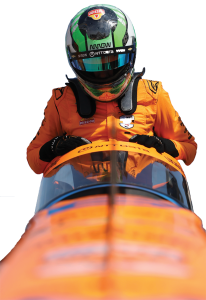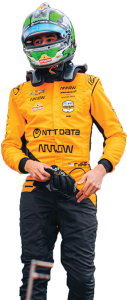Starting from humble beginnings and evolving into the glitz and glamor seen today, the Formula One industry has undergone many changes over the years. With over 200,000 attendees and an average ticket price of more than 1,000 euros, the 2024 Monaco Grand Prix was a testament to the steady growth of Formula One’s popularity. However, the most drastic shift can be seen today in terms of its audience; the diversity of Formula One viewers has increased significantly throughout the years.
Since its first Formula One Grand Prix in 1946, the Formula One industry has captivated a predominantly European audience. Adéle Vincent, a senior at the American School of the Hague in Wassenaar, Netherlands, has been a fan of Formula One since she was a kid and reflects on its importance for European families.
“It’s very common in Europe for families to watch Formula One,” Vincent said. “[Watching Formula One] is a family lineage thing, especially if you’re from a country like Italy, France or England that has a large history of races — not only Formula One but other forms of [car] racing as well.”
Charlie Wood, a junior at Regis Jesuit High School in Aurora, Colo., and a Formula One fan, reaffirms Formula One’s heavy European presence.
“[Racing] has been a European sport, built by Europeans and built for Europeans,” Wood said. “It’s been the Italians, the French and the Germans; it’s been all of them.”
Despite its European origins, Formula One has managed to expand its audience onto a more global stage. “Drive to Survive,” a Netflix series currently in its sixth season, has been one significant driving force for expanding Formula One to an American audience.
Sophia Upton, an English influencer, runs a TikTok and Instagram page, @f1.soph, dedicated to Formula One content. Upton represents a new wave of involvement with
Formula One: social media content run by women. As fans see more media in general surrounding Formula One, there is an increasing interest in the sport.
“Most of the recent Formula One fans got into it because of ‘Drive to Survive,’” Upton said. “It’s nice that there are so many new fans who got into it.”
Following “Drive to Survive,” other motorsport classes have tried replicating the series’ dynamic success. Despite their efforts, they have not been able to retain and engage new fans as “Drive to Survive” did.
A primary example of this is “A Hundred Days to Indy,” a television series based on IndyCar, an Indianapolis-based racing organization that used to have an international grasp on motorsport fans. However, due to a lack of funding and support, IndyCar was not able to sustain its international pursuits.

Nolan Siegel, a Palo Alto native and IndyCar driver for Arrow McLaren, noted that Formula One’s marketing has set it apart from IndyCar.
“What Formula One did with ‘Drive to Survive’ has helped a ton,” Siegel said. “IndyCar has not been quite as successful on that front; they’ve got their show on Netflix as well, but it hasn’t been quite as popular.”
Some individuals feel that the popularity of “Drive to Survive” can be attributed to the way the show puts its effort into appealing to the American audience.
“In ‘Drive to Survive,’ they’ve steered away from the sport itself to create the drama that American markets want to see,” Wood said.
Some people worry that the interest in Formula One is not centered on the drivers; rather, the drama of reality TV is what has kept viewers hooked.
“Editing is a powerful tool,” Vincent said. “That’s why a lot of older fans aren’t happy with ‘Drive to Survive;’ they feel like new fans are too sensitive. New fans might say, ‘Oh, this driver
is so rude!’ when it’s the reality of racing. Older fans are more aware of that than newer fans, who see it through a drama lens rather than as a
sport.”
There is a distinct discrepancy between the exaggerated plot line of “Drive to Survive” and the competitive but athletic nature of Formula One. Tarika Pillay, a junior at Palo Alto High School, highlights this difference.
“If someone starts watching Formula One from the series, they’ll think that the drivers are constantly fighting or contracts are getting terminated,” Pillay said. “They’ll think it’s a reality series instead of just a sport.”
An ex-Red Bull Racing team employee, who wished to remain anonymous for privacy reasons, expressed that “Drive to Survive” is not a complete representation of the sport.
“There is the novelty aspect of it,” the employee said. “At some point it will wear out. Hopefully, by then, you will get excited about watching races, not only the Netflix series.”
However, fans like Elsa Lagerblad, a junior at Palo Alto High School, believe that, in contrast to the dramatized nature of the series, “Drive to Survive” can be a positive force that helps fans connect with drivers.
“I know some people really don’t like [‘Drive to Survive’], but I think that it’s silly, it’s fun and it’s a good way to see more of the drivers beyond seeing them in a car,” Lagerblad said.
This tension between different types of Formula One fans is not only exemplified by differing reactions to the newer fanbase, but, more specifically, the differing reactions to the increase in women who participate in the motorsport industry in general.

Content creation is also increasing the viewer base of Formula One. Ella Coppola, the Canadian content creator behind the Instagram account @TheMotorsportsGirlies, started content creation with a lifestyle-focused account but later began a new page dedicated to creating an inclusive community surrounding motorsports.
“Since I was already posting about my life online, it felt natural to start posting about Formula One, but in a way that is true to me — by combining racing, fashion and femininity,” Coppola said. “In January of this year, my Formula One content went viral almost overnight, with 20,000 women finding me in a few days. That’s why I felt the need to create a new space online, one entirely dedicated to making Formula One friends who also love fashion and beauty.”
Additionally, content creation about Formula One directed at women can help make women feel represented in the community and want to participate more in the fan base. Melody Xu, a sophomore at Palo Alto High School, believes that content creation is a good way to target new audiences.
“They [content creators] are trying to expose it [Formula One] to a larger audience because a large percent of the population is female,” Xu said. “It would be nice to have a sport where we can all just come together, regardless of our gender, race or differences, and celebrate engineering and how far we’ve come as a human race.”
While women have existed in motorsports for a long time, the roles they serve in the community have changed dramatically over the years. The objectification of women in motorsports has been prevalent for decades.
“You would have the race girls at the start with the checkered flags who were in bikinis,” Vincent said. “Women were very much objectified in the racing world, and it was just something that was normal. If you looked at any promotion for racing, Formula One or Indycar, there were always women in bikinis.”
The push to change women’s representation in the sport has emerged in recent years: Grid Girls, who held flags along the track dressed in revealing outfits, were retired from Formula One in 2018.
In recent years, there has been an uptick in female viewership of Formula One races, but as with many fanbases, female fans have gotten a bad reputation due to prejudices surrounding their involvement.
“Female fans are often associated with the ‘fangirl’ stereotype, where they are shown as obsessive, shallow and not bringing anything new to a community,” Coppola said. “In my opinion, this rise of female involvement in motorsports helps to set the record straight, and hopefully, we will reach a future where your gender doesn’t dictate your ability to enjoy sports.”
Maya Stepanova, a sophomore at Henry M. Gunn High School, sees a similar harm produced by this “fangirl” stereotype.
“I’m a girl, and it is really good that feminism is spreading to the sport, but at the same time, there are people who are sexualizing the drivers,” Stepanova said. “There are some fans that only watch for the drivers that are ‘hot,’ and when they do that, it puts a stereotype on all women who watch motorsports.”

Long-term fans who seek to maintain the exclusivity of Formula One push these stereotypes to ostracize women. Lagerblad outlines how, within the Formula One community, the predominantly male fan base can warp women’s perceptions of one another.
“The women that first came to Formula One were pressured to fit in with this male view of the sport, which led to a lot of internalized misogyny,” Lagerblad said. “They [female fans] say things like, ‘I watch Formula One, but I’m not like other girls; I watch it for the right reasons.’ I understand why [women say that], but I don’t think that’s productive or helpful to any woman trying to watch Formula One.”
In addition to more female fans of motorsports, there have also been more women involved in the sport, from behind the wheel to behind the scenes.
“Watching the races now, every so often, I’ll look at the engineers who are changing the tires in the pit stops, and I’ll notice, ‘Oh, there’s a girl there! That’s so cool,’” Vincent said.
Racing organizations are also deliberately attempting to decrease the gender gap in the sport by hiring more women to their teams.
“Arrow McLaren, and McLaren in general, have been at the forefront of that push,” Siegel said. “We have a bunch of women working on the team as engineers and mechanics, and they’re doing a great job. It’s good to see more interest from women in the sport, both from a fan perspective and an engineer, driver or mechanic perspective.”
This increase in women has made the Formula One fan base significantly more accessible. Since more and more people are watching the sport, they will be further inclined to participate in Formula One.
“‘Drive to Survive’ has been quite a good thing in the sense that there’s a lot more inclusion,” Vincent said. “With the release of ‘Drive to Survive,’ it’s now a lot easier for women to be fans of Formula One. ‘Drive to Survive’ brought the opportunity for women to work traditionally male jobs like engineering or Head Strategist.”
Since the inception of motorsports and Formula One, the driving itself has been more geared towards men. Success at the highest caliber of racing requires training to begin at a young age. Often, drivers start out on go-karts and progress their skills as they grow, leaving women behind from the start.
“It [go-karting] seems like it’s not like a girly thing to do at a young age,” Siegel said. “The reason there aren’t many [women] at the top level is because there are so few that start at the bottom level — you can’t expect them to succeed without having the experience that everyone else has.”
Amber Slagle, a mechanic for NASCAR and a professional racecar driver, is a rare exception to this trend.
“My mom tried to get me involved in cheerleading and dance and those [traditionally] girly things, but they were just never for me,” Slagle said. “They were trying to find something that I would enjoy and be able to make friends doing, and my dad bought me a go-kart, and it just took off from there.”
Formula One Academy, a female-only championship branch of Formula One, was inaugurated in 2023. The series’ mission is to develop and prepare female drivers to move up into higher levels of motorsports (i.e., Formula Three, Formula Two and Formula One). Wood is hopeful about the Academy but also realizes the difficulty of acquiring an audience.

“This year, they’ve been doing a good job at publicizing it [Formula One Academy],” Wood said. “Lewis [Hamilton] has done a great job of supporting the drivers and the Academy itself. Since there’s a prominent driver [Hamilton] who’s working so hard to get diversity into the sport, to get women in, someday soon, there will be a female Formula One driver.”
Though there is a female-only motorsports series, there haven’t been any female drivers on the Formula One grid for years, whereas IndyCar has had multiple, albeit very few, successful female drivers since its founding.
“Right now, there’s one female driver on the [IndyCar] grid, Katherine Legge, who I was teammates with at the Indy 500 this year,” Siegel said. “The most famous [female IndyCar driver] doesn’t race anymore, but Danica Patrick drove in IndyCar for quite a while.”
While female involvement in the Formula One industry has increased and female drivers in other sectors of motorsports have become more prevalent than ever, the only way for permanent change to be made is to ensure that women have support from the very beginning of their driving pursuits.
“To have successful women drivers in motorsports, they have to start at the same age as all the boys,” Siegel said. “There has to be a push to put young girls in go-karts.”
As Formula One reaches its centennial, it’s important to note how far the sport has come since the days of dangerous tracks and misogynistic attitudes. Formula One has become a community for people from all walks of life to celebrate the pinnacle of human speed and innovation.
“It’s a great sport; it’s a great community,” Xu said. “If people want to do something on Sundays, it’s very nice to watch, and you’ll just find it fascinating, as I did.”
lightsoutand away we go











